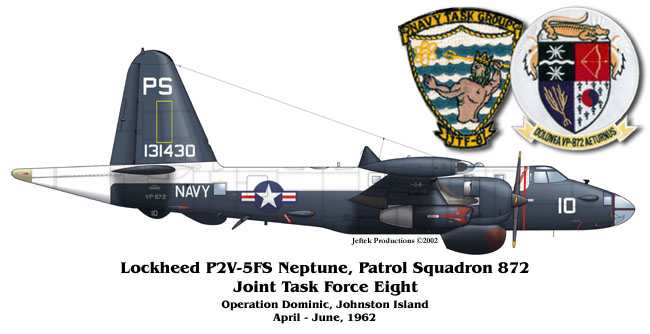|
|
 |
| The escalation of international tensions brought on by the creation of a wall separating East Berlin from West Berlin resulted in the recall of several naval reserve squadrons to meet the possible threat of further Russian aggression. Five of these squadrons were reserve patrol Squadrons, one from the West Coast, VP-872 and four from the East Coast (VP-661, VP-741, VP-832 and VP-933). All of the squadrons were recalled On 13 September 1961 with a 1 October reporting date, for a period of duty not to exceed 12 Months.
VP-872 accepted their first P2V-5F Neptune on October 3, 1961 and would fly the first ASW barrier patrol from NAS Alameda 9 days later. By November 1, 1961, VP-872 was brought up to full strength, augmented by personnel from VP-701 and VP-703 of NAS Dallas and VP-875 of NARTU Alameda, along with other reservists and TARS from NAS Dallas and NARTU Alameda. The Soviet Union, in defiance of a 34 month nuclear testing moratorium, on September 1, 1961 commenced a series of atmospheric nuclear tests. The United States immediately commenced plans for it's own nuclear testing. Operation Dominic would ultimately include 36 tests, 29 airdrops, five rocket launched tests and 2 tests of operational systems (the Polaris submarine launched ballistic missile and the ASROC anti-submarine rocket). In February 1962, VP-872 received it's orders to deploy to Barbers Point and MIDPAC. In April 1962, VP-872 was placed under the operational command of Joint Task Force 8 and began flying barrier patrols for Operation Dominic. On April 9, 1962, VP-872 Crew 6 discovered the Peruvian cargo ship SS Iquitos adrift in the restricted nuclear test area near Christmas Island. This was made all the more remarkable by the fact that the Iquitos was abandoned by her crew nearly 4 months earlier, 300 miles southeast of Acapulco, Mexico. After determining that the appearance of the abandoned cargo ship was not a deliberate menace, its 4000 mile voyage propelled by the Humboldt Current (which also carried the famous Kon Tiki raft on it's epic journey from the coast of South America to the Polynesian Islands), the Iquitos was declared a navigational hazard and the USS Gurke DD 783 was ordered to sink the still burning Iquitos. VP-872 would return to NAS Alameda in June 1962 and the squadron was finally deactivated on August 1, 1962. VP-872 had flown over 4,900 hours, 750,000 miles all the while maintaining a perfect safety record! |
